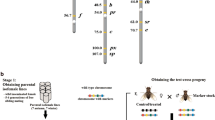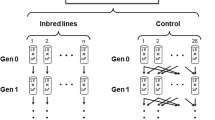Abstract
There is now ample evidence for the ubiquity of genetic variation at allozyme loci in many species1,2, but the extent to which this variation is actively maintained by natural selection remains unresolved. Although various approaches have suggested the importance of selection at some allozyme loci in laboratory populations3–6, to be fully convincing, evidence for natural selection must finally come from studies on natural populations. Inevitably, this will entail an understanding of and the potential to manipulate both the ecology and genetics of the population. Because sufficient is known of the ecology, breeding site, nutritional requirements and field behaviour of at least some species of the cactiphilic Drosophila, we7–9 and others10 have chosen them for experimental evaluation of the forces operating to maintain genetic variation. If genetic variation at some locus is being actively maintained by natural selection, the action of this selection should be detectable following artificial change in gene frequencies produced either by adding certain genotypes to the population, or by removing them from it. Jones and Parkin11 have reported unsuccessful attempts to detect selection by such perturbation experiments in Cepaea and Drosophila pseudo-obscura, while Halkka et al.12 inferred strong natural selection at a locus controlling colour polymorphism from exchange of individuals of Philaenus spumarius between two island populations. We report here results for the simultaneous perturbation of gene frequencies at three allozyme loci in Drosophila buzzatii. The changes in gene frequency following this perturbation provide strong evidence for selection, and for differential selection among the three loci.
This is a preview of subscription content, access via your institution
Access options
Subscribe to this journal
Receive 51 print issues and online access
$199.00 per year
only $3.90 per issue
Buy this article
- Purchase on Springer Link
- Instant access to full article PDF
Prices may be subject to local taxes which are calculated during checkout
Similar content being viewed by others
References
Brown, A. H. D. Theor. Popul Biol. 15, 1–42 (1979).
Nevo, E. Theor. Popul Biol 13, 121–177 (1978).
Bijlsma, R. & Van Delden, W. Genet. Res. 30, 221–236 (1977).
Cavener, D. R. & Clegg, M. T. Genetics 90, 629–644 (1978).
Morgan, P. Nature 263, 765–766 (1976).
Oakeshott, J. G. Genet. Res. 26, 265–274 (1976).
Barker, J. S. F. & Mulley, J. C. Evolution 30, 213–233 (1976).
Barker, J. S. F. Lecture Notes Biomath. 19, 403–430 (1977).
Mulley, J. C., James, J. W. & Barker, J. S. F. Biochem. Genet. 17, 105–126 (1979).
Heed, W. B. in Ecological Genetics: The Interface (ed. Brussard, P. F.) 109–126 (Springer, Heidelberg, 1979).
Jones, J. S. & Parkin, D. T. Lecture Notes Biomath. 19, 83–96 (1977).
Halkka, O., Halkka, L. & Raatikainen, M. Hereditas 80, 27–34 (1975).
Wasserman, M. Univ. Texas Publs 6205, 85–117 (1962).
Adams, J. & Ward, R. H. Science 180, 1137–1143 (1973).
Author information
Authors and Affiliations
Rights and permissions
About this article
Cite this article
Barker, J., East, P. Evidence for selection following perturbation of allozyme frequencies in a natural population of Drosophila. Nature 284, 166–168 (1980). https://doi.org/10.1038/284166a0
Received:
Accepted:
Issue Date:
DOI: https://doi.org/10.1038/284166a0
Comments
By submitting a comment you agree to abide by our Terms and Community Guidelines. If you find something abusive or that does not comply with our terms or guidelines please flag it as inappropriate.



